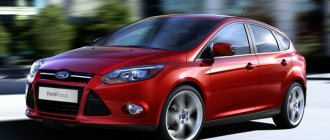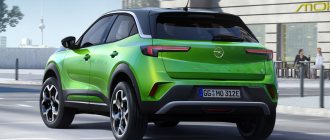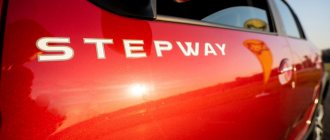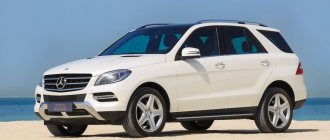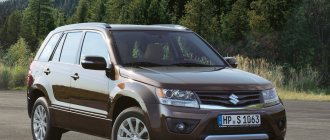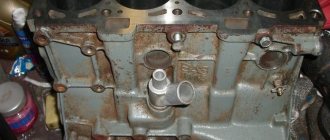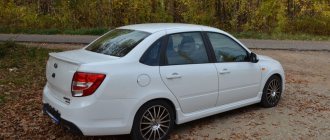Alfa Romeo 159 differs from its predecessor (“156”), which enslaved not only with its design, but also with problems in non-stop mode. The 159th has become even more attractive. She is more charming than the VW Passat and Ford Mondeo combined. It’s a pity that the “Italian” died without leaving any offspring. Maybe her receiver would be of even better quality.
If you prefer to do more than just get from point A to point B, then the Alfa Romeo 159 would meet your expectations. There is a multi-link suspension on both axles. It is configured to quickly return the body to its original position after any turn, bump or rut. Accurate driving is facilitated by a sharp steering wheel and good information content. It is worth noting that the suspension comfort level is quite good. The only thing you won’t like is the rough operation of the ASR traction control system, typical for the brand.
Alfa Romeo 159 was offered as a sedan and a Sportwagon station wagon. The latter has a slightly larger trunk than the sedan - 445 and 405 liters, respectively. Note that not all sedans offer a reclining rear seat. Based on the 159, a 4-seater Brera coupe and a 2-seater Spider were created.
Once you're in a comfortable seat, you'll appreciate the padded side panels where they meet the driver's and passenger's knees. The illumination of the indicators is easily adjusted using a button at the tip of the left steering column stalk. A little confusion can be caused by searching for the button to open the trunk from the passenger compartment. Maybe it doesn't exist at all? Yes, on the ceiling!
Engines
The range of engines used in the Alfa Romeo 159 is quite large. These are petrol 1.75 TBi (200 hp, turbo), 1.8 (140 hp), 1.9 JTS (160 hp), 2.2 JTS (185 hp) and 3.2 JTS V6 (260 hp). With.). Only the weakest 1.8 liter does not have direct injection. The strongest 3.2 JTS will most likely be of interest to gas station owners. It devours gasoline like a dragon - almost 15 liters per 100 km in the combined cycle.
In Europe, diesel modifications received the best reviews, especially with a 1.9 liter engine. There are 6 turbodiesels in total: 1.9 JTDM (120 and 150 hp), 2.0 JTDM (136 and 170 hp), 2.4 JTDM R5 (200 and 210 hp).
Alfa Romeo is famous for its gasoline engines, but in the 159th diesel engines have proven themselves better. They are one of the best in their class. The optimal choice is 1.9 JTDM with 150 hp. The 120-horsepower version is too weak for a heavy Italian. Both units are considered quite reliable, but with certain reservations. In particular, we are talking about problems with the intake manifold flaps. However, this is a common thing in modern diesel engines of any brand. But JTDM is the only one that allows you to purchase a new collector relatively cheaply (about 10,000 rubles).
The 2.0 JTDM (170 hp) is also worthy of attention. In its design it resembles a basic diesel engine. And the powerful 2.4 JTDM, which was created by adding a fifth cylinder to the 1.9 JTDM, is less reliable and more expensive to operate. Sometimes the cylinder head fails (35,000 rubles). All JTDMs are equipped with a belt type timing drive.
The most modest of the gasoline 1.8 with a return of 140 hp. borrowed from Opel. It doesn't create any serious problems. The turbocharged 1.75 TBi was developed by Italians, has good performance, sounds good, but is not durable.
The high hopes placed on the petrol 1.9 and 2.2 JTS with a timing chain drive were not justified. Unfortunately, these engines, created jointly with GM, sometimes fail. Often, after 100,000 km, you have to change the chain and gears, which cost several tens of thousands of rubles. In addition, the engine is equipped with direct fuel injection, which leads to the formation of carbon deposits.
The top-of-the-line 3.2 V6 was created by GM-owned Holden. This is a kind of slap in the face for Alpha, which until the “times of the 159th” was valued for its high-quality V-shaped sixes. The “alien” unit is too gluttonous and rude. In addition, after 100-150 thousand km, the timing chain often stretches. Sometimes it even comes to overhauling the engine (60-80 thousand rubles).
Used Alfa Romeo 159: mysterious Selespeed and Italian ICE oddities
Transmission
With 1.8 liter engines, the Alfa Romeo 159 was equipped with a manual Opel F17 gearbox, about which many bad words have already been said, including by me.
On cars with 2.2 liter and 3.2 liter engines, as well as on some cars with 1.8 liter engines after restyling, a six-speed M32 made by Getrag was installed. It is also from the Opel set and is also not at all problem-free. It causes especially a lot of criticism when paired with powerful V6 engines and 2.0 and 2.4 liter diesel engines. The Selespeed Magneti Marelli CFC300 transmission is new here. The essence remains the same, but the mechanics are the same, from the M32.
The 3.2 liter engines were immediately given Aisin’s newest six-speed gearbox at that time, the TF80SC, which fans of the brand often present as their own “innovative development, the Q-tronic automatic transmission.” Actually, all the gearboxes were received as part of an agreement with GM, and only the all-wheel drive transmission is its own, with a Torsen III center differential.
Pictured: Alfa Romeo 159 Ti & 159 Sportwagon Ti 2007-08
Of course, dual-mass flywheels have a limited resource, and after one and a half to two hundred thousand they will almost certainly require replacement or overhaul.
Manual transmissions are not as trouble-free as we would like. Owners of cars with a 140-horsepower 1.8-liter engine, which is paired with the F17, are especially unlucky. This gearbox is already recognized as frankly problematic, and on the heavy 159th it has a very hard time. We strongly recommend regularly changing the gearbox oil and checking for chips in it. However, instead of the F17, the Alfa fits perfectly with the M32, which is much stronger and quite problem-free with this engine. Moreover, station wagon cars came from the factory with this gearbox, even with a 1.8 liter engine.
Articles / Used car Alfa Romeo 159 with mileage: the noise of a premium interior and tears flooding the electrics Have you ever wanted a car that everyone would look back at? Not because she is expensive, provocative, old or outlandish, but because she is beautiful to the point of losing consciousness? So, I want everything... 14310 2 0 12/27/2017
Whether it’s possible to install F16 is a big question, and the “Alphists” don’t bother with such cross-breeding. In general, when buying, listen to the car while driving, or better yet, spin the wheels with the car hanging and listen to the box.
With all other engines and even as part of Selespeed, it works mainly with the M32, also known as the C630 according to the FIAT classification. This box is more durable, but it also suffers from bearing problems and oil leaks. With leaks, it’s clear: the oil seals on GM cars are not very good, and neither are the Italians’, so it’s just destined to lose oil. And without oil, the box does not work for long.
The bearings here die not only of the secondary shaft, but also of the primary one. It doesn’t take that long to change them, and the need for this operation is revealed by the sound of the engine running. When replacing bearings, try to set the thrust shims correctly: old bearings will definitely not last long.
The differential also copes poorly with its responsibilities. After 10 years of service, it is better to check the axle shaft play and noise. And the best thing is to open it and check everything in place. You don't need to change the oil that often, but it's still worth doing it once every 40 thousand. But monitoring the oil level and the condition of the magnets must be carried out at each maintenance.
Pictured: Alfa Romeo 159 '2008–11
The whine of the secondary shaft is not audible while driving, and the problem is identified when it is too late. Working in tandem with “torque” engines with a mileage of 150 thousand often leads to disruption of the third gear synchronizers, despite the fact that they are triple. It’s good that there are enough Opel spare parts, and repairs are not that expensive. Just in case, we inform you: secondary shaft bearings are numbered NP854792/NP430273, NP238750/NP929800, primary shaft bearings are NP797735/NP430273 and NP030522/NP378917. SNR or Timken bearings are highly recommended as replacements; they are not always available in the originals.
Occasionally there are post-restyling cars with an F40 manual transmission. These are mainly cars with two-liter diesel engines. This box is noticeably stronger than the M32. But there are no standard clutch kits for it for a non-dual-mass flywheel. This gearbox has no problems with the differential; problems with the shaft bearings rarely occur, even with long mileage or depressurization of the unit. There is definitely no need to be afraid of cars with this manual transmission.
Selespeed, which is often found on cars with a 2.2 liter engine, is also not to be afraid of. This is not Easytronic, or even AMT Lada Vesta. The robot on the Alphas works an order of magnitude better, although there is a congenital drawback in the form of a pause in traction. But it is very small here, and with powerful engines it is less noticeable. Jerking when switching and revving the throttle is just his style, you need to get used to it.
Note that the 159 has what every semi-automatic transmission needs: steering wheel buttons to change gears, so you don't suffer from lag during spirited driving. Just engage the downshift in advance, as with a manual transmission. And there is also a sport mode, in which the mechanics of the gearbox and the engine suffer more, but the sound is like a real Ferrari!
If there is a malfunction, of course, there will be shocks, jerking beyond the permissible limit, delays in switching, and a whole bunch of other troubles. In the event of any serious problem, the robot will simply stand up and not go in emergency mode, like a classic automatic transmission.
This box on the 159th is very different in design from its predecessors. First of all, because the clutch hydraulic cylinder is standard, Opel, combined with a release bearing. And the pressure in the system is noticeably lower, the hydraulic accumulator and electric pump of the system operate under more gentle conditions, which is why the requirements for the seals are also not so stringent. In addition, the capricious potentiometers from the TPS, which were used on previous Selespeed models, were replaced with non-contact sensors that do not require adjustment.
Pictured: Alfa Romeo 159 Ti '2007–08
But Magneti Marelli, as always, is able to please. For example, at low temperatures, seals do not work. In addition, there are a number of sensors with a limited service life. Thus, the common error P0914 means that it is time to replace the gear selection mechanism position sensor 71748012. Its price is about 8,500 rubles. Errors in pressure occur either as a result of leaks or loss of elasticity of the cuffs.
Selespeed requires two fluids - brake fluid in a common reservoir with the brakes and its own Tutela Speed CS. The fluid from approval sheet MB 345.0 for Sequentronic is also suitable. It is recommended to change brake fluid and oil once a year, or at least once every three years.
If possible, oil seals should be replaced with frost-resistant ones, and not with original ones (for example, from Renault 309300676R).
The service life of the mechanical part and clutch with regular adaptation of the grip point is higher than that of a manual transmission. The clutch often lasts for 150 thousand or more kilometers. The electronic part is mostly troublesome, especially if there is no specialist in this design and a proprietary scanner nearby. The corrugated wiring to the pump is falling apart, the wiring to the sensors is a little more durable, but also does not last long in our climate.
Articles / Practice Alternative to DSG: typical malfunctions of the Aisin TF-60SN automatic transmission It is believed that “classic” automatic transmissions are more reliable than preselective DSG boxes. And for this reason, many are willing to significantly overpay just to buy a car without “that terrible DSG.” Sometimes I feel... 62560 14 2 11/28/2017
The Q-Tronic automatic transmission is Aisin’s TF80SC unit, long known from Volvo, Opel, Saab, Ford and Mazda. This six-speed gearbox is somewhat different from another series of six-speed gearboxes, Aisin TF-60SN , which I have already reviewed in detail, but the main problems are the same. This is a valve body that is sensitive to contamination, which is difficult to repair if it is seriously worn, and there is a lack of original repair solenoids (only the valve body assembly is supplied as spare parts, otherwise you will have to use compatible third-party manufacturers and calibrate the automatic transmission yourself). Also, the weakest point of this box is the gas turbine engine with blocking linings and the cooling system, which can greatly reduce the life of the unit.
On jogging cars, traditionally, the Direct drum, which is responsible for 4-5-6 gears, suffers from the kinematic scheme adopted by Aisin. In turn, its problems are associated with wear of the Teflon seals and the drum seat. Also, with mileages of more than 250 thousand or regular races with full torque, the brake band will require replacement.
On the Alfa 159, the box cooling system is not designed in the best way, with a simple heat exchanger, but this option works great with diesel engines. With a 3.2 liter engine, the box in city mode still heats up over 110 and even 130 degrees, which does not contribute to a long service life.
Under normal operating conditions, it is recommended to change the oil every 30-40 thousand on gasoline engines and every 50-60 on diesel engines. For gearboxes paired with a gasoline engine, it is recommended to install an external radiator and filter. To better preserve the valve body, it is better to change the oil very often, every 15-20 thousand kilometers. This does not greatly increase the cost of operation, but can protect you from large unexpected expenses.
The all-wheel drive design is exactly the same as that used on the Lancia Delta Integrale/Alfa Romeo 155 twenty-five years ago: a Torsen center differential, and a simple gearbox at the rear. The most vulnerable point of the system is the cardan shaft. Its intermediate support is located exactly above the catalysts and is the first to die. A spare part from BMW is perfect for replacement, but the shaft is solid, and you still can’t do without service for cardan shafts.
In the transfer case and gearbox, it is important to check the oil every 30 thousand and change it every 60 thousand. And the main thing here is to check: 0.6 liters of fluid in the transfer case will easily leak if the seals are damaged. And given that both engines and gearboxes are not dry, it is difficult to detect a leak visually. Just check.
Motors
Almost all engines require careful attention to plastic parts and wiring in the engine compartment. Wiring breakdowns are one of the most common causes of malfunctions in gasoline engines.
2.2 liter engines have another unpleasant nuance: the quick-release connector of the fuel line leaks, which is easy to understand by the smell of gasoline. If you see a white clamp, change the part immediately. Moreover, you don’t need to buy an expensive original: in any store with spare parts for the GAZelle you will find what you are looking for - pipe 405.4216 is simply one to one.
Leaking expansion tanks are also about the Alfa 159. Change the plugs more often, pour antifreeze according to the norm and a good, high-boiling one. And, of course, keep the temperature normal, if possible - less than a hundred degrees. Low-temperature thermostats are available for all GM engines. Some components of the cooling system can be selected from the 156th Alpha, which is significantly cheaper.
With GM engines, the situation is not as simple as it might seem at first glance. The 1.8 liter MPI engine is the same as the Opel Z18XER engine without any special changes. Look at any Opel review - this is a reliable and simple engine, moderately torquey, but it has a hard time in a large and heavy car. And the box is very “stretched”, so the car will not drive dynamically. The engine problems are the same as on Opels: heat exchanger, weak thermostat, phase shifter clutches, valves and weak plastic of the cooling system. But the ECU is located better here than on the Opel, and there are practically no problems with breakdowns.
In the photo: Under the hood of Alfa Romeo 159 '2006–08
The 2.2 JTC engine is structurally close to the Z22YH engines used in Opel. There are enough common parts, but the 2.2JTC has adjustable timing and a different intake. And as a result, he has 180 hp in his arsenal. versus 155 for Opel.
Timing chain kit 2.2
price for original
11,155 rubles
Among the Italian oddities, I would like to note the drive of the pump, oil pump and balancers by one chain. Now the price of a timing chain kit has dropped significantly and no longer poses a problem for users, moreover, half of the “horror stories” from Opel’s Z22SE do not apply to this engine: a cylinder head made of normal cast aluminum holds the timing mechanism studs and spark plugs tightly. The engine life is not bad by modern standards - for 300 thousand, even in our conditions.
The service life of timing chains and tensioners and balancers varies depending on the volume of oil in the crankcase, its temperature, operating conditions and oil purity. The minimum service life when changing the oil every 15 thousand kilometers and using low-viscosity Dexos-II oils is about one hundred thousand kilometers. Under more gentle operating conditions, lower operating temperatures, good oil and other favorable factors, you can achieve a service life of over 250 thousand, which is just excellent.
Everything can be ruined only by a low pump resource. It is driven by a chain, and if it leaks you will have to go into the timing belt.
There is another nice thing: the cylinder liners can be replaced without even cutting them out. There are no repair sizes, but parts are inexpensive and very common. In general, the design is very technologically advanced, although with expensive attachments and some lack of quality materials.
For tuning fans, we will inform you that there are also turbo versions of the same engine. For example, B207. There are also compressor ones, but they are intended for the USA. The potential is limited by a weak cylinder block, which will have to be replaced at a torque of more than 400 Nm.
Pictured: Under the hood of the Alfa Romeo 159 Ti '2008–11
Like other Opel engines, leaks and dirty intake from the ventilation system are guaranteed. The situation is complicated by direct injection. The intake valves become very dirty; after just a few years of operation, the engine cannot produce full power due to a clogged intake.
Radiator
price for non-original
Nissens, 11,562 rubles
The insufficient resource of the membrane injection pump has now been practically eliminated. If you refuel in Moscow or St. Petersburg, then the gasoline almost certainly has special lubricating additives. In the outback the situation is more complicated, but the pump can withstand 40-60 thousand mileage even in such conditions. Of course, if you change the fuel filter in time and do not allow the tank to dry out.
The 3.2L engine also has a lot in common with GM engines. For example, with a turbocharged 2.8 Z28NET or naturally aspirated 3.2 with Antara/Captiva. The block is the same, but the cylinder head is from the 3.6 liter versions with direct injection. There is nothing surprising: the engine was supplied to Holden from a factory in Korea, and there is nothing Italian about it. In principle, a completely reliable engine. True, the Busso engine was better , but they couldn’t or were too lazy to bring it up to Euro 5 standards.
Pictured: Alfa Romeo 159 '2005–08
The thermal package is large, and the radiators need to be monitored very carefully. Any contamination or failure of one of the fans leads to serious problems. For example, the cylinder head gasket breaks, or the engine starts to eat oil.
The timing life is relatively low, it is unlikely to last more than 150 thousand, but also less than 80 thousand. Again, like the 2.2 motor, a lot depends on the operating conditions of the chain.
Ignition module 2.2
price for original
16,049 rubles
The service life of the ignition modules is low, and changing them in the back row is difficult. The vacuum system of the motor is branched and complex, there are many places for leaks. With this engine, the service life of the exhaust system corrugations is short; after five years of operation, get ready to change them.
The new supercharged 1750Tbi is a new engine, and there is not much data on it. Along with excellent traction, efficiency and noise levels, problems with the cooling system were noted in early copies. But it is unlikely that they have not been resolved seven years later. Occasionally, the engine control unit fails (MagnetiMarelli is involved again). But overall there are no complaints about the engine. Or they are simply difficult to find, because there are very few cars with this engine; it is practically never found on 159.
Diesel engines are mainly represented by 1.9-liter four-cylinder FIAT engines and 2.4-liter five-cylinder engines. There are also newer two-liter engines.
Pictured: Alfa Romeo 159 Sportwagon Ti '2007–08
All engines are considered very successful. Of course, there are typical diesel problems such as a dirty EGR; on older cars, increased attention should be paid to variable geometry turbines. Where the DPF filter has not yet been removed, it can cause a lot of trouble: it is difficult to clean unless you make long trips on the highway, and requires a special fluid and a service mode for forced cleaning. These diesel engines are distinguished by their high sensitivity to fuel quality.
In addition, the characteristic problems of all diesel engines on the Alfa 159 are a vulnerable oil radiator located in front of the main one, and a tendency to carbon deposits at the intake. Carbon deposits can jam the air blocking valve, which is designed to quickly kill and prevent "carryover." The power supply system of these diesel engines is well diagnosed electronically; by adapting the injectors, you can understand what condition they are in and how “alive” the engine is.
Pictured: Alfa Romeo 159 Sportwagon '2006–08
1.9 liter engines appeared on the Alfa 156, and these were immediately versions with Common Rail and supercharging. The original versions of the engine with an eight-valve cylinder head are still considered a model of simplicity and reliability, but their 280 Nm and 120 hp. not enough for comfortable movement. Version with 320 Nm and 150 hp. with a 16-valve cylinder head provides a noticeable improvement in dynamics, but more powerful versions were not installed on the 159.
Timing belt kit with pump 1.9 / 2.4 JTD
price for non-original
Gates, 6,667 rubles
It is very important to change the timing belt drive on time and not to forget about replacing the service belt, its pulley and rollers. The timing belt does not last 150 thousand, but only 60-70, and is often limited in life by the pump, which is prone to jamming. And if the engine compartment is heavily soiled and there are problems with the air conditioning compressor, the service belt can go even shorter.
Glow plugs in regions where winter temperatures are less than 25 degrees do not last long, and there are complaints about the need for replacement almost every year. Well, the service life of a dual-mass flywheel on the weakest diesel engines will not please you.
In addition to purely mechanical problems, there is always the possibility of failure of one of the sensors or even breakdown of the wiring to the injectors. The control system is quite complex, and its own faults should not be neglected. The system is also sensitive to the operation of the fuel pump in the tank: if its mesh is dirty or worn, difficult to diagnose malfunctions in the engine may occur. And checking the fuel pressure is a mandatory procedure in case of any failures. If the diesel particulate filter cleaning procedure starts too often and lasts more than 15 minutes, check the turbine for oil leaks.
Pictured: Alfa Romeo 159 '2005–08
The 2.4 liter engine is the same 1.9 liter, but with one more cylinder. With a power of 200-210 hp. This is a very sporty option. Moreover, it is combined with both all-wheel drive and automatic transmission. Technically, the engine is no different from small-volume ones. The same problems, but a slightly greater load on the cooling system and slightly more obvious problems with contamination of the intake manifold. The EGT sensor at the outlet is more loaded and fails more often.
Two-liter engines differ little from 1.9-liter engines. The cylinder diameter has grown by 1 mm, they have become even more sensitive to overheating and “overblowing”. And EGR is here with gas cooling, in a single unit with a thermostat. And here surprises are possible. The heat exchanger is leaking, and if you are very unlucky, you can get a water hammer. Antifreeze leaks are also common. This part is not cheap, as is the new “electronic throttle”, which in the same way becomes overgrown with soot. Unlike a vacuum-driven throttle, in an electronic throttle the valves break when jammed.
Pictured: Alfa Romeo 159 '2005–08
In general, the engine design turned out to be slightly more complex than that of the 1.9 liter, but the price for improved traction, increased power and reduced carbon formation was a slightly more expensive design.
Summary
Everything is clear with the design: Alfa Romeo 159 is one of the most beautiful cars that you can buy for sane money. And the chassis of this car is quite modern and very reliable, with excellent handling, especially in the Ti versions after restyling and with light engines. The choice of power units is quite wide, among them there are no outright failures, but there is no ideal either. The latest 1.8 TBi looks great, but is not widely used and hardly cheap to maintain, and Opel's petrol engines are rather boring for such a flashy car. Diesel engines are very good, but in Russia diesel is still not the best choice for a passenger car: there are too many complications and unforeseen expenses.
Pictured: Alfa Romeo 159 '2008-09 & 159 Sportwagon '2008-11
Unfortunately, in terms of technology and the feeling of quality, Alfa still lags behind German premium cars, and in terms of price on the secondary market it is not much inferior. This is a choice for those who value beauty and are willing to put up with increased risks.
However, you don’t have to completely believe garage bikes. The engines and suspensions are quite reliable, the body is strong, and the interior is not bad. Spare parts are also available for sale. You can even find and order “used” components, although you will have to wait a long time for delivery from Poland or Italy. So if you are willing to overpay a little for beauty, then there are no serious obstacles to this. Just find the “right” service, of which there are few even in Moscow and St. Petersburg. In the regions, it is unlikely that there will be a workshop where you will be served competently. Especially if your car has a Selespeed robot or there are some serious electrical problems.
Private opinion
Engine
2.0 JTDM, 170 hp
I am the owner of a 2010 Alfa Romeo 159 with a rare 2.0 JTDM engine with 170 hp. Previously owned a 1998 Alfa Romeo 156 1.8 TwinSpark.
For a long time I put up with huge regular investments in the 156th model . And yet I was struck by the “Alpha Virus” from the first sight of these cars... And the 159th was a dream! Fell in love with a copy with a light leather interior.
I thought that I would put up with the rattling two-liter turbodiesel and the unsporting (in my stereotypical thinking) nature of the absorber of “odorous” fuel. But how wrong I was! The dynamics of the diesel Alfa are simply amazing.
Photo: Grigory Kolodyazhny
Acceleration to 100 km/h
7.5-8 s
I got the car undamaged, well-maintained, and serviced by Fiat/Alfa officials in Rostov-on-Don. Immediately after the purchase, on the way from Rostov to Pyatigorsk, I encountered the first problem: the drive shaft vibrated. The previous owner had already replaced the left short drive assembly. Replacing the tripod did not yield anything: due to the powerful and torque (360 Nm) engine, the tripod glass breaks, and the entire drive with the intermediate shaft and CV joint assembly has to be replaced. I ordered from Britain on eBay, since in Russia I could not find a part for my modification. My drive is different from those on versions with 1.9 JTDM and 2.4 JTDM. The first repair cost more than 50 thousand rubles.
But, to my surprise, during the 3 years of ownership I only changed consumables: fluids, brake pads and discs, timing belt with rollers. Naturally, like all diesel drivers, I couldn’t resist removing the environment with a slight increase in power. As a result, I got an economical, comfortable “car” that easily outshines virtually any car with naturally aspirated gasoline engines up to 3 liters in volume. Personal measurements show stable dynamics of acceleration from 0 to 100 km/h in 7.5-8 seconds.
Photo: Grigory Kolodyazhny
Fuel consumption per 100 km
7-8 l
Currently the mileage is 181 thousand km. The chassis is all factory except for one upper control arm and drive shafts. There are no knocks or crunches. Fuel consumption on a cruise on the highway is 5 liters, in the combined cycle - 7-8 liters with a rather aggressive driving style. From replacement to oil change (every 6 thousand kilometers) you have to add approximately 300-400 grams. The car is truly eye-catching! The diesel engine is fairly quiet, especially when driving long distances at speeds above 100 km/h.
There are indeed electrical problems. Previously, in wet weather, the parking sensors and the hill holder system refused to work. Replacing the parking sensor corrected the situation until next winter. Now it has refused again, and at the same time the parking sensors began to work after opening the trunk, and not engaging reverse gear...
The 159th Alpha also has a problem with a weak halogen head low beam. It was shining terribly. After disassembling the headlights, I expected to see cloudy reflectors, but found a layer of dust on the lenses and reflectors.
Photo: Grigory Kolodyazhny
Overall, I’m more than happy with the car and still don’t see any alternatives in its price category, especially when it comes to diesel. As much as I regretted buying the 156th model, I am just as pleased with the purchase of the 159th!
No wonder Jeremy Clarkson said: “I have argued many times that buying an Alfa is the portal through which all drivers must go if they really want to know how a car is different from a toaster or a washing machine.”
Survey
Would you take an Alpha 159?
Your voice
Total votes:
Transmission
The drive is of course front-wheel drive, but there are also all-wheel drive modifications, designated Q4. In such options, traction is distributed along the axles in a ratio of 43/57 - front/rear. The Torsen center differential is responsible for this. But enough excitement. Most often, all-wheel drive came in addition to the power-hungry 3.2 V6 JTS, less often 2.4 JTDM (210 hp). The all-wheel drive system is reliable, but the outboard bearings and driveshaft spiders wear out over time.
The engines were paired with a 5- or 6-speed manual transmission, an automated Selespeed transmission, and a Q-Tronic automatic transmission. The least critical comments are received by classic assault rifles - the Japanese Aisin TF-80SC.
One of the weak points of the model is the M32 manual gearbox, which can break down by 200,000 km, and even earlier for active drivers. Increasing noise precedes complete failure of the box - the bearings fail. Repairs will require specialized equipment. Some companies offer boxes after regeneration. The fact that owners of diesel modifications most often encounter this problem indicates that the “mechanics” do not cope well with high torque.
Difficulties in engaging manual gears arise due to wear of the complex cable mechanism for selecting gears or the clutch. At the same time, it must be taken into account that in any Alpha 159 the speeds are turned on with some resistance.
The Selespeed robot is based on the M32. However, bearing problems are less common here. Interruptions in operation are most often caused by the failure of gear selection sensors - 2 pieces for 8,000 rubles. Sometimes the clutch slave cylinder also fails.
Chassis
The “159th” suspension is a further development of the 156th multi-link design. However, it should be emphasized that the manufacturer has improved its quality. If in the old model the chassis rarely lasted more than 40,000 km, now it can last up to 100,000 km. Analogs often force you to take up repairs again after 20-40 thousand km. This applies not only to levers (3-4 thousand rubles), but also to front wheel bearings (from 5,000 rubles). Rear bearings and levers last more than 150-200 thousand km.
In Alfa Romeo 159 during the first years of production, the steering rack was affected by corrosion. As a result, the system lost its tightness. Reiki restoration is a complex and ineffective procedure. Sometimes owners complain about howling power steering. Changing the fluid helps.
Below Expectations
The Italians hoped that they could effectively compete with the premium middle class. However, sales results showed that the main German rivals were out of reach. The best year for Alfa Romeo 159 was 2007, when more than 65,000 copies were sold. Meanwhile, European customers preferred more than 295,000 BMW 3, 220,000 Audi A4 and about 176,000 Mercedes C-Class. In subsequent years, demand fell. When sales reached 10,000 units in 2011, the manufacturer decided to discontinue production of the model. The car was offered in showrooms until 2014 (remains were sold out).
Model history
2005 – presentation at the Geneva Motor Show in a sedan body. Engines: petrol - 1.8 (140 hp), 1.9 JTS (160 hp), 2.2 JTS (185 hp), 3.2 JTS V6 (260 hp) with all-wheel drive 4x4 Q4 and turbodiesels - 1.9 JTDM (120 hp, 150 hp), 2.4 JTDM (200 HP).
2006 – debut of the station wagon. Robotic gearbox with 2.2 JTS Selespeed, automatic Q-Tronic with 1.9 JTDM (150 hp) and 2.4 JTDM.
2007 - 2.4 JTDM diesel engine (210 hp), also with 4x4 Q4; automatic Q-Tronic with 3.2 V6 JTS.
2008 – slight restyling, 3.2 JTS V6 with front-wheel drive.
2009 - 1.75 TBi petrol engine (200 hp, turbo), 1.9 JTDM Eco diesel (120 hp), 2.0 JTDM and 2.0 JTDM Eco (both 170 hp).
2010 - diesel engine 2.0 JTDM (136 hp).
2011 - end of production, there was no successor.
Review of Alfa Romeo 159 / Alfa Romeo 159
The Alfa Romeo 159 was first presented at the Geneva Motor Show in 2005 as a sedan. The new product is built on the Fiat Premium platform, which was used in the Brera, Spider and the Kamal concept car. The exterior of the Alfa Romeo 159 was created by Italian designer Giorgetto Giugiaro in collaboration with Alfa Centro Stile. The style of the new car has many similarities with its predecessor, the Alfa Romeo 156. Note that during its creation, the developers were based on the Alfa Romeo Brera coupe concept, which was presented back in 2002. The front of the car has a traditional V-shaped grille. Grouped cylindrical headlights are located under the overhanging part of the hood, which gives the car a more aggressive look. The model has a rather dynamic silhouette, with clearly defined lines. Compared to the Alfa Romeo 156, the 159 has become larger, which in turn has increased the space in the cabin. The wheelbase is 2700 mm, the length of the car is 4680 mm, width - 1828 mm, height - 1417 mm.
The interior of the Alfa Romeo 159 is quite restrained and quite aesthetic. The Alfa Romeo brand has always been famous as a manufacturer of cars for the driver, so you can see that the dashboard is noticeably turned towards the driver's seat. Round instrument dials and polished metal trim give the interior a sporty feel.
Alfa Romeo 159 is offered to the buyer with both front-wheel drive and all-wheel drive under the name Q4. The all-wheel drive system uses Torsen III technology with a dual differential. Torsen technology was developed by the American corporation Gleason. The name Torsen is short for “TORque SENsing”, which translates as “torque sensation”. By default, rear receives 57% of the torque, forward - 43%. For all-wheel drive models, two powertrain options are offered: a 3.2-liter gasoline engine with 260 hp. and a 2.4-liter diesel with 200 hp. (until 2007). Front-wheel drive models are equipped with 1.9 (160 hp), 2.2 (185 hp) liter gasoline engines and 1.9 liter (150 hp) diesel engines. All 3 variants of gasoline engines are JTS (Jet Thrust Stoichiometric) systems, that is, direct fuel injection systems.
As for the transmission, new gearboxes have been developed for the Alfa Romeo 159: a manual gearbox with a sports shift mechanism, a Selespeed robotic gearbox and a QTRONIC automatic gearbox. They are all 6-speed.
The standard equipment of the car includes: anti-lock braking system (ABS); Brake assist; electronic brake force distribution (EBD), driver and passenger airbags, side airbags, seat belt pretensioners; “active” head restraints, child seat mounts, electric front and rear windows; heated mirrors; electric mirrors; climate control; on-board computer; remote opening of the trunk lid; remote opening of the gas tank flap; automatic switching on of headlights; headlight adjustment; power steering; height adjustment of driver and passenger seats; central locking; immobilizer; electronic key identification system; audio training; CD radio; alloy wheels; bumpers in body color; fog lights.
Additional equipment includes: cruise control; navigation system; Rain sensor; control of vehicle functions on the steering wheel; heated front seats; electric driver and passenger seats; leather interior; xenon headlights; headlight washer; MP3 radio, CD changer, amplifier and subwoofer.
In 2006, at the Geneva Motor Show, the Alfa Romeo 159 was presented as a station wagon. In 2007, engineers increase the power of the 2.4-liter diesel engine to 207 hp.
At the 2007 Geneva Motor Show, Alfa Romeo is showing the sporty TI (Turismo Internazionale) versions of the 159 model sedan and station wagon. The Alfa Romeo 159 TI sports car received a new aerodynamic package, lowered sports suspension, large-diameter tires, 19-inch alloy wheels, Brembo brakes with red-painted calipers, chrome exhaust pipes and the same exterior mirrors.
Optional differences between TI models and civilian ones include: heated sports bucket seats; leather trim on the steering wheel and gear lever; instruments designed in a sporty style, aluminum pedals.
The 159 TI sedan and station wagon can be equipped with diesel or one of the gasoline engines, including the top version 3.2 V6 with an all-wheel drive system. Alfa Romeo 159 TI cars can be painted in three colors: Alfa Red, Stromboli Gray and Carbonio Black.
Technical characteristics of Alfa Romeo 159 (2005-2011)
| Version | 1.75 TBi | 1.8 | 1.9 JTS | 3.2 V6 | 1.9 JTDM | 1.9 JTDM | 2.0 JTDM | 2.4 JTDM |
| Engine | gasoline turbo | petrol | petrol | petrol | turbodies | turbodies | turbodies | turbodies |
| Working volume | 1742 cm3 | 1796 cm3 | 1859 cm3 | 3195 cm3 | 1910 cm3 | 1910 cm3 | 1956 cm3 | 2387 cm3 |
| Cylinder/Valve Arrangement | R 4/16 | R 4/16 | R 4/16 | V6/24 | R 4/8 | R 4/16 | R 4/16 | R5/20 |
| Maximum power | 200 hp / 5000 | 140 hp / 6500 | 160 hp / 6500 | 260 hp / 6300 | 120 hp / 4000 | 150 hp / 4000 | 170 hp / 4000 | 210 hp / 4000 |
| Maximum torque | 320 Nm / 1400 | 175 Nm / 3800 | 190 Nm / 4500 | 322 Nm / 4500 | 280 Nm / 2000 | 320 Nm / 2000 | 360 Nm / 1750 | 400 Nm / 2000 |
| Dynamic characteristics | ||||||||
| Maximum speed | 235 km/h | 208 km/h | 214 km/h | 250 km/h | 197 km/h | 207 km/h | 218 km/h | 231 km/h |
| 0-100 km/h | 7.9 s | 10.2 s | 9.5 s | 7.0 s | 10.7 s | 9.6 s | 8.8 s | 8.1 s |
| Average fuel consumption | 8.1 l/100 km | 7.8 l/100 km | 8.7 l/100 km | 11.4 l/100 km | 5.2 l/100 km | 6.8 l/100 km | 5.1 l/100 km | 6.8 l/100 km |
Personal experience of the owner of Alfa Romeo 159: what makes it attractive?
Tell us how you came to buy an Alfa Romeo, especially a station wagon?
Different people value different things in cars: some reliability, some power, some prestige... But for me the main factor was rarity. Alfa Romeo in Russia is not a common car, but at the same time it is not exactly a niche product - you can still buy it. Plus, owning an Italian car means a lot in itself. This is passion, albeit mixed with disorder.
Owner: Anton Kovalev, editor-in-chief. Driving experience: 15 years.
So how did you buy your Alfa Romeo 159 Sportwagon?
This car had only one owner in Russia before me. This is a guy from St. Petersburg who was once specifically looking for a white station wagon with a black interior. When it was still profitable to transport cars from Europe, he bought this Alfa in Munich, drove it around St. Petersburg for five years, and then decided to sell it. I found his ad on the Internet and bought a car in the summer of 2021, but my search took a long time. I actually started my day by looking at ads and spent 8 months doing it!
Engine 2.4 l 200 hp Year of manufacture 2009. Mileage 250,000 km. Approximate price 800,000 rubles. The color “white pearl” is not original. The owner of an Alfa Romeo 159 Sportwagon had it repainted because the entire body of the car was covered in chips.
Wow! And was the effort worth it?
Undoubtedly! Before that I had a Citroen, and, in comparison, the Alfa Romeo is a big step forward. Although the Citroen I had was not entirely simple, but with hydropneumatic suspension, I no longer want to return to modern models of this brand. I was looking for something interesting for myself! I was also attracted by the fact that this Alfa Romeo 159 has a diesel engine with an odd number of cylinders – there are five of them.
Before purchasing the car, it was decorated with various stickers, which Anton removed while repainting. Of these, only the Italian flag on the mirror remained. In the future, the owner plans to apply the same image to the mirrors, but airbrushed.
Okay, then a purely practical question. Where do you service your car? Alfa Romeo is a rare guest in our area...
Details about Alfa Romeo's 600-horsepower hybrid coupe revealed
Who's faster: BMW M2, Alfa Romeo 4C or Lotus Exige 350 Sport?
Hyundai N Performance is preparing an exotic car that no one expects
I have friends who repair cars. It doesn’t matter to them what kind of car I bring, and they’ve already sorted out the Alfa Romeo. By the way, there have already been problems in terms of repairs. The most serious thing: one day the car began to have trouble starting. I thought it was the timing belt. They changed it, but the problem did not go away. They searched further, but nothing worked, the mechanics were already on the verge of breakdown... And then they decided to look at the crankshaft pulley, it turned out that the problem was there. When the pulley was replaced, the problem went away, but before that the car sat for a whole month for another reason - due to a shortage of spare parts...
Tell us more!
There are few spare parts for Alfa Romeo in Russia. Of course, there are companies that deal with them, but you need to wait another month, since deliveries come straight from Italy. But I have friends in Poland, where there is no such problem. So I called a friend, they brought this part to him in one day, and then there was a very long chain: from Poland the spare part was transferred to Belarus, and from there to Moscow. The scheme is quite complex. But within a week I already had the part I needed! And in Russia we also have bad catalogs: sometimes you order a part, but it doesn’t fit.
According to Anton, diagnostics during maintenance showed that the car’s last oil change was at around 315,000 km. This indicator is greater than the mileage displayed on the odometer. But this feature does not bother the owner.
Wow! I didn’t even think that such difficulties still existed! And if you ignore the shortage, is the Alfa Romeo 159 Sportwagon expensive to maintain?
That pulley repair cost about 30,000 rubles, since the first part did not fit, and we also changed the timing belt. My friends do maintenance for me, so I only pay for “consumables” - 5,000–7,000 rubles. For a diesel engine, the Alfa Romeo 159 has quite high fuel consumption in the urban cycle - about 13 liters per 100 km. But on the highway, on the contrary, it is small - a little more than 5 liters. An MTPL policy costs about 6,000 rubles.
The three-spoke steering wheel, bucket seats and pedal pads immediately set the driver of the Alfa Romeo 159 in a sporty mood.
Do you often drive?
I travel around the city on weekends, plus sometimes I travel 600 km away to my hometown of Klintsy in the Bryansk region, although I don’t travel even 10,000 km in a year. But the car makes me happy! She is beautiful, dynamic, her acceleration to hundreds is about 6 seconds, and you can “pile on” normally. And people in the stream pay attention! And if you meet another Alfa Romeo, then greeting with headlights is a must!
